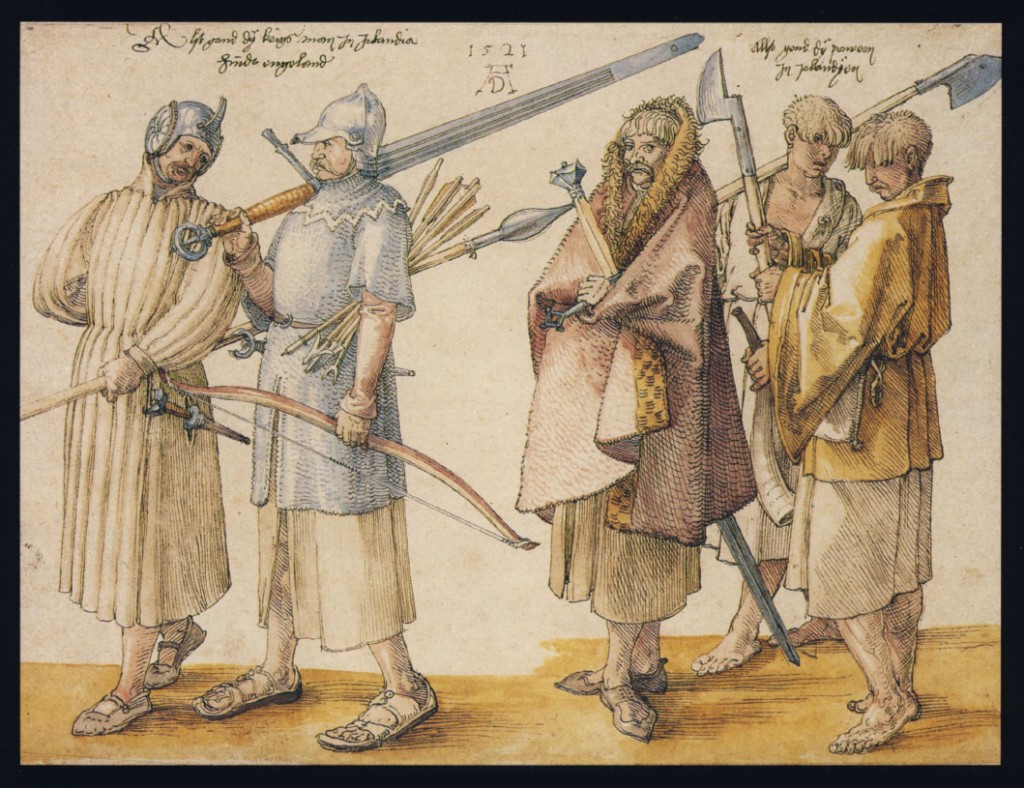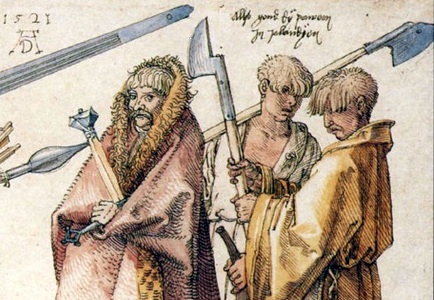I recently spotted what appeared to be remarkably modern looking haircuts in Albrecht Druer’s woodcut of 1521 AD[i]. This image shows a group of Irish soldiers[ii], most likely mercenaries, who were fighting on the European continent during the early 1520s. I soon discovered that, far from being unusual, this distinctive hairstyle was actually very popular amongst the native Irish during the 16th century.
Referred to as a ‘glib’ this style involved the hair at the back and side of the head being trimmed short, while at the front and top it was allowed to grow long, resulting in a large fringe, which fell down over the face.
In 1517 Laurent Vital described this distinctive Irish hair style thus: ‘for they (Irish men) were shorn and shaved one palm above the ears, so that only the tops of their heads were covered with hair. But on the forehead they leave about a palm of hair to grow down to their eyebrows like a tuft of hair which one leaves hanging on horses between the two eyes’[iii].
Seen as a particularly Irish haircut it was despised by the English establishment and attempts were made to outlaw it in 1537[iv] and again in the 1570s[v]. However, it remained persistently popular and appears to have been worn as badge of honour amongst Irish kerns (soldiers).
In c. 1596 the famous English poet, Edmund Spenser, deplored this ‘thick curled bush of hair, hanging down over their (the Irish) eyes’ and compared it to a thief’s mask[vi]. He also rather fancifully stated that the Irish believed that this heavy fringe of hair could deflect the strike of a sword, ‘going to battle without armour on their bodies or heads, but trusting to the thickness of their Glybbes, the which (they say) will sometimes bear off a good stroke’[vii]. This last assertion, however, has probably more to do with Spenser’s own anti-Irish prejudices, rather than any genuine belief held by the Gaelic Irish.

[i] The entire image shows two groups of men, the first are heavily armed and appear to be gallowglasses, the second (discussed here) are more lightly armed and probably represent kerns
[ii] These particular men are actually described as ‘Irish peasants’ in Druer’s image
[iii] Archduke Ferdinand’s visit to Kinsale in Ireland, an extract from Le Premier Voyage de Charles-Quint en Espagne, de 1517 à 1518. Corpus of Electronic Texts, accessed 8/8/2013
[iv] Statute of the Irish Parliament (1537), 28 Henry VIII, chapter xv. Accessed 8/8/2013
[v] Berry, R. G. 1907 ‘The Whites of Dufferin, and their connections’ in The Ulster Journal of Archaeology, pp. 89-95
[vi] Edmund Spenser ‘A View of the present State of Ireland’. Corpus of Electronic Texts, accessed 8/8/2013
[vii] ibid
.




Leave it to the Irish to be trailblazers of fashion! 🙂
This haircut was used by the Vikings 600 years earlier. And they traded with Ireland. You don’t need to thank Scandinavia for Dublin 🙂 Consider it a gift 😉
Funny that they tried to outlaw it… ban it and it will flourish 😉
It kind of made a comeback at least in rural Ireland in the 90’s , they do look more like Gallowglass than native Irish though and their hair was painted as being very fair which isn’t that common in adult Irish males.
Those were nordmen. Not exactly “Irish” natives.
I’m not sure what you mean Erry?. These soldiers are described as Irish in the original 16th century woodcut. The men of the right with the ‘hipster’ haircuts are most likely Irish kerns. Their hair, clothes and weapons would be typical of Irish foot-soldiers of this period. The men on the left may or may not represent ‘gallowglass’ warriors. With origins in the northern isle’s of Scotland, by the 16th century most ‘gallowglass’ were probably Irish born.
As far as I know the models that Durer used were not in fact Irish soldiers at all but sea merchants who had docked in the city which he was living….
Looks like the noble guy is wearing one of the recent fashion trends – The Manket!
Paul Galvin Kerry Footballer loves the Manket
Here is what one looks like – http://www.aransweatermarket.com/manket
This is the perfect website for anyone who hopes to
understand this topic. You know a whole lot its almost tough to argue with you (not
that I personally will need to…HaHa). You definitely put a brand new spin on a topic that’s been written about for ages.
Great stuff, just wonderful!